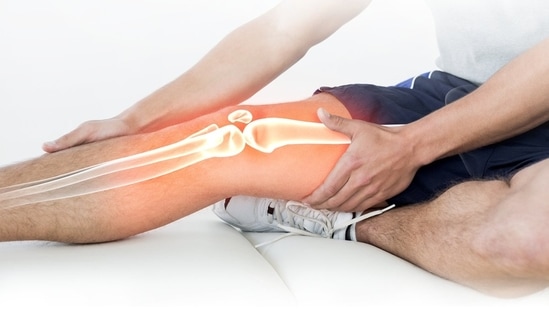Rheumatoid arthritis vs osteoarthritis: Know the difference - Hindustan Times
While there are various forms of Arthritis, the two most common types of this joint disease today would include Osteoarthritis (OA) and Rheumatoid Arthritis (RA). Here's all you need to know about their root causes, common symptoms and other differences

There are more than 100 different forms of arthritis, although osteoarthritis (OA) and rheumatoid arthritis are the most prevalent (RA) but in contrast to RA, which primarily affects the immune system and can damage joints as well as muscles, connective tissue, tendons and fibrous tissue, OA is the wear and tear of the cartilage that protects the ends of the bones and can harm any joint, including the hands, hips, knees and spine. According to an examination of arthritis tests performed in SRL Diagnostics' laboratories, there are more than 180 million cases of arthritis in India, making it more common than many other well-known diseases including diabetes, AIDS and cancer where every year, approximately 14% of Indians seek medical attention for this joint condition.
In an interview with HT Lifestyle, Dr Deeksha Katiyar, Consulting Physician at WeClinic™ Homeopathy, explained, "While there are various forms of Arthritis, the two most common types of this joint disease today would include Osteoarthritis (OA) and Rheumatoid Arthritis (RA). While OA causes cartilage damage and leads to the formation of tiny bony outgrowth i.e. osteophyte; on the other hand, RA is an autoimmune disorder wherein our immune system attacks the joint and thereby destroys the lining of certain joints, causing swelling in the joints and eventually causing deformity."
Osteoarthritis:
According to Dr Deeksha Katiyar, some of the common signs and symptoms of OA include:
1. Pain
2. Stiffness in joints that may worsen during morning
3. Swelling and redness in joint
4. Decreased range of movement
She elaborated, "The root cause or trigger of OA can be due to inadequate calcium in body, poor nutrition and menopausal issues. For managing the symptoms of OA along with treating constitutional defects i.e. the hereditary tendency for OA, homoeopathy can prove to be a great option. Some commonly-used homoeopathic medicines in this regard are Bryonia, Rhus Tox, Arnica, Ruta, etc; along with those medicines, constitutional remedies like Calcarea Carb, Sulphur, and Tuberculinum also provide remarkable and wonderful results. They not only manage the pain and swelling but also give permanent relief of OA symptoms; and more so if there is no precipitating cause like hypothyroidism, diabetes, etc."
Dr Shubham Raghuvanshi, General Physician at Civil Hospital, Tissa, Chamba, Himachal Pradesh added, "A common form of arthritis is Osteoarthritis or OA wherein those joints that are close to the tips of the toes, fingers, and joints of lower limb like hip, knee more affected. OA is, in fact, a degenerative joint disease that usually occurs in the elderly age groups, and adversely affects the articular cartilage. Pain is usually the earliest symptom of OA; swelling seen is often at later stage. In treatment of OA, analgesic medication can be used to suppress pain and chondroprotective agents to enable repair of damaged cartilage. Whereas supportive therapies like weight reduction therapy in obese patients, stress avoidance, local heat application to the joint can also be helpful to relieve pain. Additionally, there are also surgical options that include osteotomy and joint replacement."
Rheumatoid Arthritis:
Dr Deeksha Katiyar highlighted that in case of RA, the common symptoms are:
1. Morning stiffness that lasts for 30 minutes or more
2. Onset in smaller joints like feet and hands
3. Fatigue
4. Low-grade fever
While it is difficult to cure RA due to its autoimmune nature, Dr Deeksha Katiyar revealed that clinically it has been witnessed that full recovery from RA is possible over the long term if one consumes homoeopathy medicines such as Colchicum, Actaea Spicata, Rhus Tox, Bryonia Alba etc as per doctor's guidance. She added, "At the same time, one must alongside follow a strictly healthy lifestyle i.e. avoid intake of high protein diet, do exercise/Yoga, physiotherapy and avoiding triggers such as sudden change weather, etc."
Dr Shubham Raghuvanshi said that Rheumatoid Arthritis is believed to be an autoimmune disorder. Some of the common symptoms or associated clinical features that strongly suggest RA are:
1. Morning stiffness
2. Swelling of three or more specified joints
3. Swelling of joint(s) in the hand and wrist
4. Symmetrical swellings
5. Rheumatic nodules
6. Fever
7. Weight loss and fatigue
He shared, "Joints affected by RA commonly are the MP joint of the hand, PIP joint of fingers, wrist, elbow etc. Recovery from RA can be medical, surgical and/or rehabilitation based. The medical recovery includes the use of disease-modifying drugs, non-steroidal anti-inflammatory drugs and steroids. Surgical options include synovectomy, soft tissue repair, arthroplasty, etc., and physio/rehab options may include joint mobilisation, splints and application of walking aids."
Personalise your news feed. Follow trending topics



Comments
Post a Comment